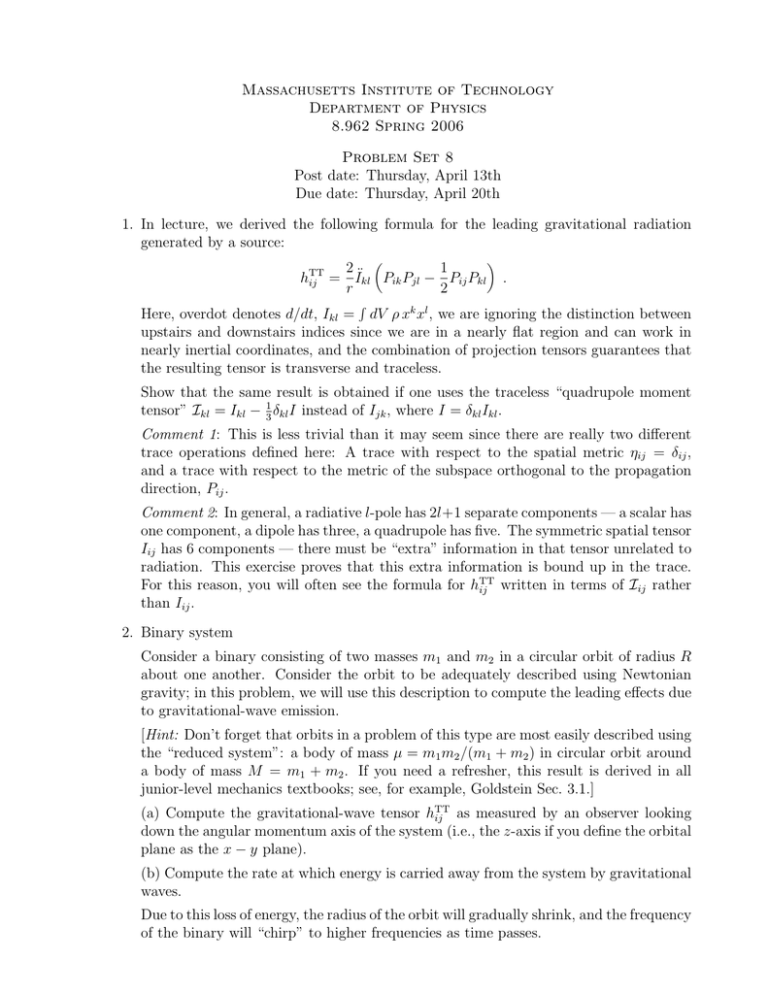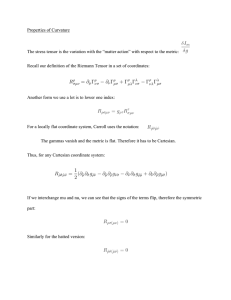Document 13650329
advertisement

Massachusetts Institute of Technology Department of Physics 8.962 Spring 2006 Problem Set 8 Post date: Thursday, April 13th Due date: Thursday, April 20th 1. In lecture, we derived the following formula for the leading gravitational radiation generated by a source: hTT ij 1 2 = I¨kl Pik Pjl − Pij Pkl r 2 � � . Here, overdot denotes d/dt, Ikl = dV ρ xk xl , we are ignoring the distinction between upstairs and downstairs indices since we are in a nearly flat region and can work in nearly inertial coordinates, and the combination of projection tensors guarantees that the resulting tensor is transverse and traceless. � Show that the same result is obtained if one uses the traceless “quadrupole moment tensor” Ikl = Ikl − 31 δkl I instead of Ijk , where I = δkl Ikl . Comment 1: This is less trivial than it may seem since there are really two different trace operations defined here: A trace with respect to the spatial metric ηij = δij , and a trace with respect to the metric of the subspace orthogonal to the propagation direction, Pij . Comment 2: In general, a radiative l-pole has 2l+1 separate components — a scalar has one component, a dipole has three, a quadrupole has five. The symmetric spatial tensor Iij has 6 components — there must be “extra” information in that tensor unrelated to radiation. This exercise proves that this extra information is bound up in the trace. For this reason, you will often see the formula for hTT ij written in terms of Iij rather than Iij . 2. Binary system Consider a binary consisting of two masses m1 and m2 in a circular orbit of radius R about one another. Consider the orbit to be adequately described using Newtonian gravity; in this problem, we will use this description to compute the leading effects due to gravitational-wave emission. [Hint: Don’t forget that orbits in a problem of this type are most easily described using the “reduced system”: a body of mass µ = m1 m2 /(m1 + m2 ) in circular orbit around a body of mass M = m1 + m2 . If you need a refresher, this result is derived in all junior-level mechanics textbooks; see, for example, Goldstein Sec. 3.1.] (a) Compute the gravitational-wave tensor hTT ij as measured by an observer looking down the angular momentum axis of the system (i.e., the z-axis if you define the orbital plane as the x − y plane). (b) Compute the rate at which energy is carried away from the system by gravitational waves. Due to this loss of energy, the radius of the orbit will gradually shrink, and the frequency of the binary will “chirp” to higher frequencies as time passes. (c) By asserting global conservation of energy in the following form, d (Ekinetic + Epotential + EGW ) = 0 , dt (1) derive an equation for dr/dt, the rate at which the orbital radius shrinks. [Hint: Don’t forget that for circular, Newtonian orbits, there is a simple relationship expressing Ekinetic + Epotential as a function of r, as well as a simple result for the orbital frequency as a function of r (Kepler’s 3rd law).] (d) Derive the rate of change of the orbital angular frequency Ω due to gravitationalwave emission. You should find that the masses only appear in the combination M ≡ µ3/5 M 2/5 , perhaps raised to some power. This combination of masses is known as the “chirp mass”, since it sets the rate at which the frequency “chirps”. 3. Wave equation for the Riemann tensor in linearized theory As we have emphasized from time to time, there is a nice analogy between the metric of GR and the electromagnetic potential, and likewise between curvature tensors and the electromagnetic field. This suggests that it should be possible to build a wave equation for the curvature tensor. As background to this problem and the next one, recall that the Einstein field equations can be written in the trace-reversed form Rµ αµβ = Rαβ = 8πT̄αβ where T̄αβ = Tαβ − 12 gαβ T γ γ . To keep things simple, we begin with linearized theory, working in nearly inertial coordinates: gµν = ηµν + hµν with ||hµν || � 1. (a) To linear order in h, the Bianchi identity can be written ∂α Rβγµν + ∂β Rγαµν + ∂γ Rαβµν = 0 . Using this equation, show that the divergence of the Riemann tensor is related to the gradient of the trace-reversed stress energy tensor: � � ∂α Rα βγδ = 8πG source involving gradient of T̄µν . (b) Now use the Bianchi identity and the solution to part (a) to develop a wave equation for the Riemann tensor of the form � �Rαβµν = 8πG source involving double gradients of T̄µν . � Solve this equation (formally) using the radiative Green’s function introduced in lec­ ture. (c) Now specialize to a plane gravitational wave propagating in the z-direction through vacuum. The corresponding solution to the above wave equation takes the form Rαβµν = Rαβµν (t − z). Using the Bianchi identity and the symmetries of Riemann, show that the only non-zero components of the Riemann tensor are of the form Ri0j0 (plus components that are trivially related by symmetries; recall that indices i, j only refer to spatial indices). (d) Show that the only non-zero Ri0j0 are Rx0x0 (t−z) = −Ry0y0 (t−z) and Rx0y0 (t−z) = Ry0x0 (t−z). The first non-zero components correspond to the + polarization discussed in lecture; the second corresponds to the × polarization. (e) Define fields h+ (t − z) and h× (t − z) in terms of these components of the Riemann tensor by 1 Rx0x0 = − ∂t2 h+ , 2 1 Rx0y0 = − ∂t2 h× . 2 Also recall the expression for the Riemann tensor in linearized theory: Rαβµν = 1 (∂α ∂ν hβµ + ∂β ∂µ hαν − ∂α ∂µ hβν − ∂β ∂ν hαµ ) 2 TT TT TT Comparing these two forms, show that h+ = hTT xx = −hyy , h× = hxy = hyx . (f) Show that when one rotates the coordinate system about the waves’ propagation direction (i.e., about the z-axis) by an angle θ [so that x� + iy � = (x + iy)e−iθ ], the gravitational-wave fields h+ and h× transform such that h�+ + ih�× = (h+ + ih× )e−i2θ This equation is equivalent to the statement that the graviton is spin 2 — the quantity h+ + ih× has “spin-weight” 2. 4. Nonlinear wave equation for the Riemann tensor Begin now with the full Bianchi identity: �α Rβγµν + �β Rγαµν + �γ Rαβµν = 0 . (a) Develop the fully covariant analog to your answer to part (a) of problem (3): � �α Rα βγδ = 8πG source involving covariant gradient of T̄µν . � (b) Using the Bianchi identity and the solution to part (a), develop a nonlinear wave equation for the Riemann tensor of the form �Rα βγδ = 8πG [source] . In this case, the source should involve three kinds of terms: double covariant gradients of T̄µν , coupling of T̄µν to the Riemann tensor, and coupling of Riemann to Riemann. Here, the operator � = �µ �µ . Comment: This non-linear wave equation was first developed by Roger Penrose, and is sometimes called the Penrose wave equation. A variant of this equation based on an expansion around the Riemann tensor for a black hole spacetime was developed by Teukolsky and has played an extremely important role in astrophysical relativity research.

